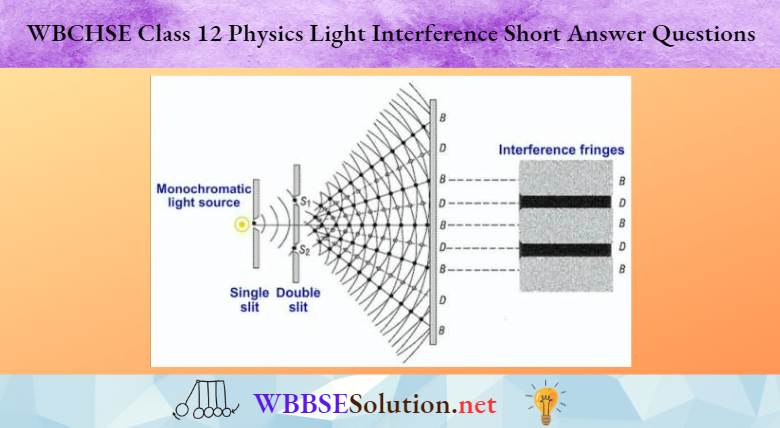LightWave And Interference Of Light Short Question And Answers
Question 1. What change will he observe in the interference pattern produced in Young’s double silt experiment, If a blue colour of the same intensity is used Instead of a yellow colour?
Answer: We know, the fringe width wavelength of incident light. The wavelength of blue light is less than that of yellow light. Hence on using blue light, fringe width will decrease
Question 2. In a double slit experiment using white light a white fringe is noticed on the screen. What will be the change in the position of the white fringe if the screen is shifted 0.05 m from the slits?
Answer: The white fringe is the central bright fringe. Its position does not change even when shifting the screen.

WBBSE Class 12 Light Interference Short Q&A
Read And Learn More WBCHSE Class 12 Physics Short Question And Answers
Question 3. Why did Huygens Introduce the concept of secondary wavelets?
Answer:
Huygens introduced the concept of secondary wavelets to define the new position of a wavefront
Question 4. What is the distance between the first bright fringe and the first dark fringe in an interference pattern? (use con vocational symbols)
Answer:
The distance between the first bright fringe and the first dark fringe is half of the fringe width. Fringe width = A, where 2d = distance between the sources, A = wavelength of inci¬ dent light and D = distance of screen from the pair of sources.
Requred distance = \(\frac{D}{2 d} \cdot \lambda \times \frac{1}{2}=\frac{D}{4 d} \cdot \lambda\)
Question 5. In all interference patterns, the width of a dark fringe Is y1 and that of a bright fringe is y2. What will be the relation between y1 and y2?
Answer:
In an interference pattern, the width of a dark fringe is equal to that of a bright fringe. Hence, in this case, y1 = y2

Common Short Questions on Interference Patterns
Question 6. Monochromatic light was used in Young’s double slit experiment, for producing Interference fringes. If a thin mica sheet Is held on the path of any of the super-posing light beams what change will be noticed in the fringe pattern? ,
Answer:
On placing a thin mica sheet the path of any of the superposing light beams’ fringe width will remain the same but the entire fringe pattern will shift.
Question 7. What is the justification for applying the principle of linear superposition of wave displacement in explaining the distributions in interference and diffraction patterns?
Answer:
The linear combination of the wave equation is also an equation. This is the very basis of the superposition of waves. a wave
Question 8. When a low-flying aircraft passes overhead, sometimes a slight shaking of the pictures on our TV screen is observed. Why?
Answer:
The metallic body of the low-flying aircraft reflects the TV signal. Interference takes place between these reflected rays and the direct rays transmitted by the TV. Hence slight shaking of the pictures is observed.
Question 9. The width of an interference fringe is 1.5mm. What would be the width of the fringe if the separation between the slits is made twice the original value?
In the first case, y = \(\frac{D}{2 d} \lambda\)
= 1.5 mm
Where 2d = distance between the slits
In the second case, the distance between the slits = 2 (2d)
∴ y’ = \(=\frac{D}{2 \times 2 d}\)λ
= \(\frac{1}{2}\left(\frac{D}{2 d} \lambda\right)\)
= \(\frac{1}{2}\) × 1.5 = 0.75mm
= 0.75 mm
Question 10.
- State one defect of Huygens’ wave theory.
- Prove the laws of reflection by using Huygens’ principle
Answer:
1. According to Huygens’ principle each point on the second wavefront emanating from the source acts as a source and from this source wavelets are supposed to spread out uniformly in all directions including in the direction of the source But in reality, no such back wavefront exists and Huygens principle fails to explain the reason behind the absence of back wavefront.
| Class 11 Physics | Class 12 Maths | Class 11 Chemistry |
| NEET Foundation | Class 12 Physics | NEET Physics |
Question 11. In a certain medium, the path difference of 5 × 10-5 cm corresponds to a phase difference n. Estimate the speed of the light waves of frequency 3 × 1014 Hz in the medium
Answer:
Wavelength (λ) of the light waves used = path difference due to a phase difference of 2π = 2x (5 × 10-5)
= 10-4cm = 10-6 m
∴ Speed of the light waves = νλ = (3 × 1014) × 10-6
= 3 × 108 m.s-1
Short Answer Questions on Young’s Double Slit Experiment
Question 12. In Young’s double slit experiment, the fringe width is 2.0 mm. Determine the separation between the 9th bright fringe and the 2nd dark fringe
Fringe width =2.0 mm. So the distance between the second dark fringe and the third bright fringe
⇒ \(\frac{\text { fringe width }}{2}\)
= 1.0 mm
Again, the distance between third bright fringe and 9th bright fringe =(9 – 3) × 2.0 = 12.0 mm
So the distance between the second dark fringe and 9th bright fringe
= 1.0+12.0 = 13.0 mm = 1.3 cm
Question 13. How does fringe the width, and distance in Young’s double slit experiment change the when of separation double between slit expert
Answer:
Fringe width, y = \(\frac{\lambda D}{2 d}\) where D is the distance between the slit and the screen.
So, if D is doubled then y is also doubled.
